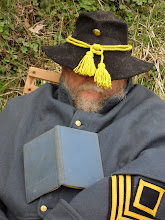From the paper - Proper timing of priest burial in montane environments: A history and prospectus.
We were kicking grave side services around over on the Catholic Writers' list a while back (we had to because someone who will remain nameless' blasted dragon swallowed our political football) and it reminded me of a grave side service that involved a former boss--call him Kelly. Kelly put himself through art school working as an undertaker at a funeral home in Virginia's Blue Ridge Mountains.
One time, they had a Catholic burial that included a grave side service. The ground at the cemetery was so rocky the grave had to be dug with a backhoe, resulting in an over-sized hole. To give the priest a place to stand at the head of the coffin, boards covered over with fake grass carpeting were placed around the grave. The priest arrived a few minutes before the family. Father was a bit old-fashioned and wore a biretta. As the family approached from the parking lot at the bottom of the hill, the priest stepped to the head of the coffin and vanished. Kelly and his assistant whirled and looked in all directions. Kelly said that he happened to glance down and there was Father's biretta sticking up out from beneath the coffin. Apparently, the priest had stepped on a spot were two boards had moved apart and gravity took it's course. While his assistant ran down the hill to stop the family, Kelly helped Father from the hole. The service was conducted by the mud bespattered clergyman without further entertainment. According to Kelly, Father took it well, for the most part, remarking that to be a good priest, one had to throw oneself into it. He also said while it (pointing to the grave) was the destination of all, he really hadn't expected to get there quite that fast.
As a Note,
The last passenger pigeon, a female, died in the Cincinnati Zoo on this day in 1914. During the 19th century, single flocks of over 2 billion covering an area of 1 mile (1.6 km) by 300 miles (500 km) were counted (estimated?) during migrations. Rather than being wiped out by sports hunters, they were destroyed by market hunters who shipped boxcar loads the eastern U.S. cities for the restaurant trade . Leaving this country boy with one question: Did y'all enjoy y'all's supper?
Certainly makes one appreciate the conservation work done by and paid for through donations, license fees, and taxes on ammunition by sports hunters through organizations such as Ducks Unlimited and others.
Thus endeth today's lesson.
Also on this day, something happy. Alberta, bringing with it one of the richest dinosaur fossil deposits around the Red Deer River, joined the rest of the Canadian confederation. Oh, yeah, Saskatchewan joined too--but they seem to have a dearth of dinosaurs. If you ever get the chance, check out Drumheller and the Royal Tyrrell Museum.
1 September 2010. Feast of St. Lupus of Sens. Montrose defeats Covenanters in Battle of Tippermuir 1644, Mission San Luis Obispo de Tolosa founded 1772, Germans capture Emperor Napoleon III of France at Battle of Sedan 1870, Tokyo and Yokohama destroyed by Great Kanto earthquake 1923, Germany invades Poland 1939.
Subscribe to:
Post Comments (Atom)




Great story! :)
ReplyDelete